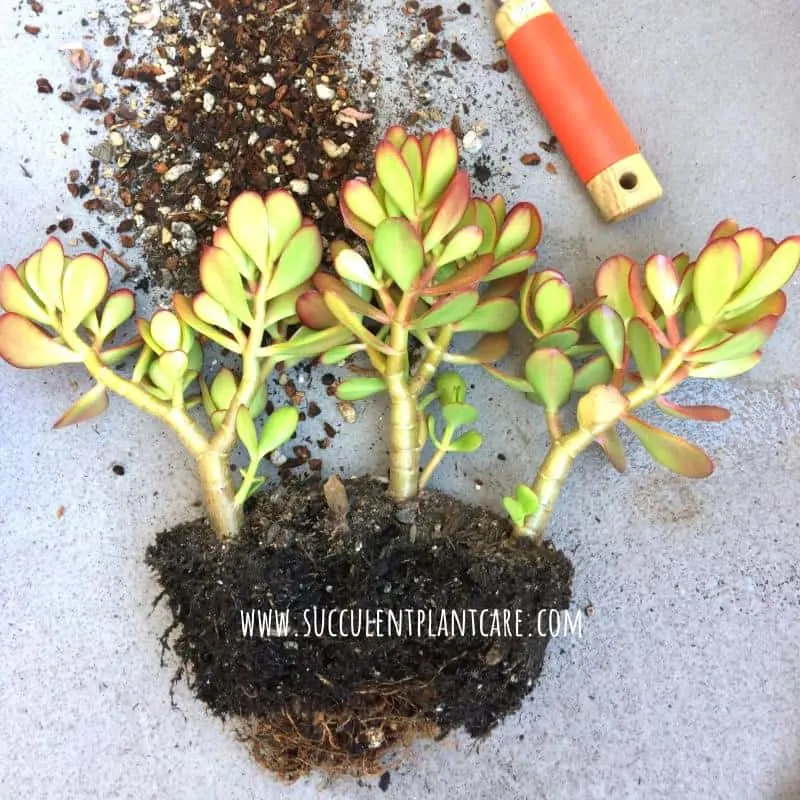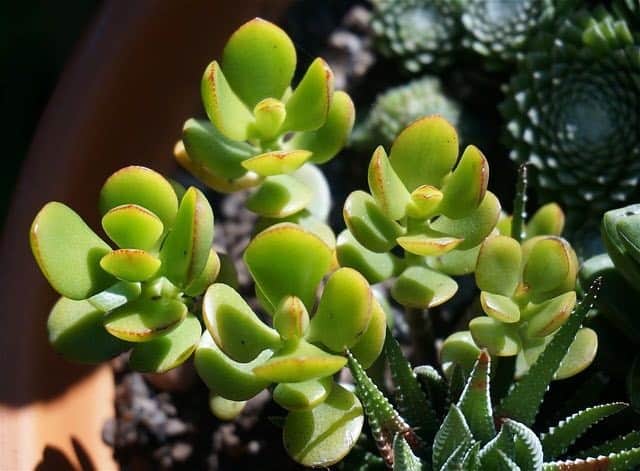Jade plant (Crassula Ovata) is one of the most resilient plants that you could have in your home, but even this plant can experience some issues. What can cause a jade plant to fall over and how to fix it?
The most common reasons for a jade plant falling over are overwatering or underwatering, having a type of soil that doesn’t drain well, and overfertilizing it. Your jade plant could also be falling over because of temperature extremes or improper amounts of sunlight, or by simply being top-heavy.
Fortunately, these problems can be recognized easily and solved if you react on time. If you want to know more causes and solutions for a jade plant falling over, read on.
Jade Falling Over Due To Too Much Water

The jade plant is a succulent, meaning that it doesn’t need a ton of water to survive. In fact, too much water could destroy it. It’s far better to not give it enough water than to overdo it since that would make this problem easy to fix. However, overwatering often causes root rot, which could be the end of your plant.
One surefire way to know if you’ve been overwatering your jade plant is to check the roots. If they are white, dry and don’t smell bad, then the plant is healthy — and it’s falling over for other reasons. If the roots are soft, brown, and sometimes emit a smell, you have a slightly bigger issue. Another way to tell is by looking at the stems, which will be mushy if overwatered.
To solve this issue, you will have to gently remove the overwatered soil from the jade plant roots, remove the roots that are damaged the most, and then repot the plant in dry, appropriate soil while making sure that you water it properly.
Hopefully, you’ll catch this issue on time before the roots are too infected.
Jade Falling Over Due to Not Enough Water

Not giving your plant enough water isn’t such a big issue, since you can always make up for it with proper watering techniques. Jade plants are used to not having enough water for days or weeks, so they will fare quite well in those conditions.
Make sure that you follow these tips for watering this plant. For one, the soil needs to be dry before watering. You should check the surface, but also deeper into the soil. You can check this with your finger or with a different tool. Once you determine that the ground is completely dry, you can move on to watering.
This will usually happen every two to three weeks during summer and a bit less during colder seasons. But the best way to know is to check. Mature plants that are more established generally need less water than younger, smaller jade plants.
When watering, make sure that the soil is watered thoroughly. Allow it to drain properly. If there are any plates or containers beneath your pot, make sure they are dried and checked for water later, if the soil drains more.
Jade Plant Soil Not Draining Properly

Another common issue with jade plants is if the soil is not draining well. This is a big problem as it may not be that easy to notice, and you could get root rot just like with overwatering. So, you need to make sure that you get good soil right from the beginning and give your plants the best chance to survive.
You need to get the right mix of soil, and the best one is a fast-draining potting mix. Cactus/succulent potting mix combined with perlite or pumice has worked really well for my jade plants. Try not to use peat, since it doesn’t react well with water, repelling it rather than allowing the water to absorb well and drain well.
Jade Plant Not Having Enough Sun Light

Every plant needs a certain amount of light. The jade plant is the same — if not given enough light, the stems will start to stretch out over time. It will start to fall over, and it will not be as shiny and healthy. The leaves will get heavier and the stems thinner and weaker, and this problem could sneak up on you without you even noticing until it’s a bigger issue.
One way to solve this is to ensure that your plant gets plenty of light. However, you should also know that more light won’t fix existing issues right away. It will take some time before the plant looks healthy again. You may need to remove stems that are already weak.
Give your plant plenty of sunshine without putting it directly in the way of hot sun rays or direct sunlight. Otherwise, the jade plant will start to shrivel and get sunburned if not acclimated to really intense heat. Generally, about four hours of being in the direct sunshine are enough, and 4-6 hours of sunlight a day is what the plant needs.
The Temperatures Are Too High or Low
Another common cause of the jade plant falling over is if it gets too hot or too cold. They prefer medium temperatures, not the extremes, although they can withstand the cold at a maximum of 40°F (4°C), or even a little lower. At the same time, temperatures much higher than 85°F (29°C) can cause the plant to dry out and droop so they need to be protected from extreme heat or heatwaves.
Ideally, you want to stay above 65°F (18°C), and avoid keeping them in an area cooler than 40°F (4°C). But these plants are very resilient and can get acclimated to harsher temperatures over time.
Try to keep them in their best conditions both during the day and during the night. Over winter, you should probably take them in if your area gets heavy snow or frost. If it doesn’t get too cold during winter in your area, this shouldn’t be a big issue.
Try to find the best middle ground, so you don’t have to move the plant around a lot.
Too Much Fertilizer
Jade plants don’t need much in terms of fertilization, so you won’t have to bother much with feeding the plant. They will need some nutrients, though, so they can grow properly. However, fertilization isn’t an all-year-round deal, and you’ll only have to fertilize once a year during spring or summer. Never feed this plant during winter.
Fertilizer isn’t always the best for the roots, so make sure that you don’t overdo it. If you do, repot the plant but with an appropriate amount of fertilizer. Compost in small amounts is also a good idea. Make sure that the fertilizer you choose has the right nutrients for the jade plant so that you can avoid root burn.
Fertilizer designed for succulents/cacti, diluted to 1/4 to 1/2 strength is what I normally use around the jade’s growing season in the summer and spring months. But again, I do not feel the need to fertilize that much or that often.
Jade Plant Repotting

Jade plants don’t like to be handled a lot. They do best when they are just left alone. So, repotting could be an issue and cause falling over. Whenever you can, try not to repot it as it can cause this plant a lot of stress. Unless it’s a root problem, avoid repotting.
If you want to repot them for growth, you can do it every two to three years, but not more if you want to avoid drooping for some time after repotting.
Jade Plant Being Top-Heavy

As a jade plant grows and matures, the plant can become top-heavy. This is actually pretty common for jade plants because of the way they grow and branch out.
When a jade plant becomes top-heavy, or the top becomes too heavy for the bottom stem to support it, it can fall over. When this happens, you can cut the part that fell over and repot it in a fresh potting mix that is fast-draining.
You can also avoid this from happening by trimming the plant every now and then to control its growth and also to reshape the plant.
Final Thoughts
While the jade plant is pretty easy to maintain and keep alive for a long time, you will still run into issues from time to time. When you do, don’t panic because these plants are very resilient. Find the cause of an issue to find the best way to solve it. In the case of a jade plant falling over, most of the time it’s a minor issue that has a quick and easy solution.
Remember that the jade plant doesn’t like to be handled that much so it is best to leave it alone. If you provide the right conditions, you shouldn’t have any problems with this wonderful plant.
Other care articles specific for Jade Plants
Jade Plants Wrinkled Leaves – Jade Plant Falling Over – Jade Plant Leaves Turning Yellow – Jade Plant Branches/Leaves Shriveling/Drooping – Jade Plant Care, Propagation and Types

